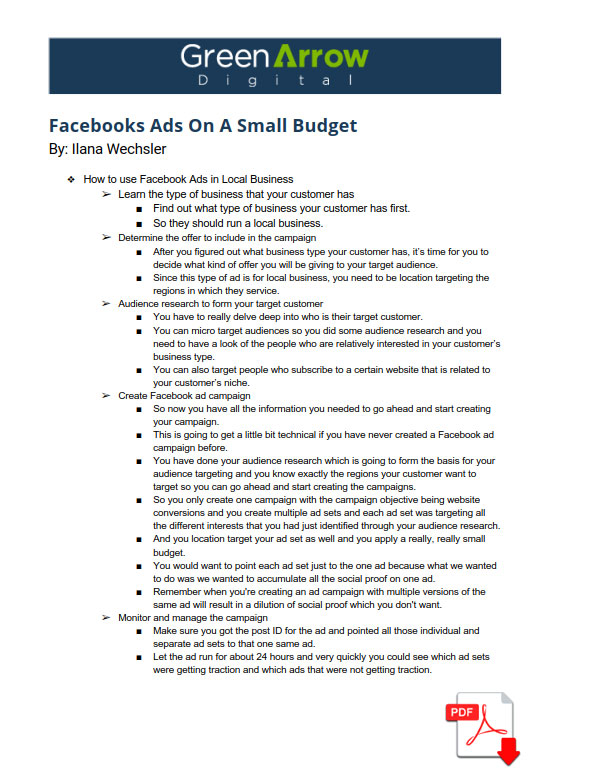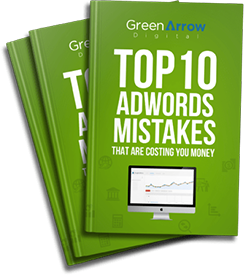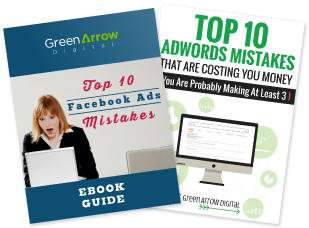In the podcast:
01:57 – How to use Facebook Ads on a small budget
01:59 – What type of business does your customer has?
02:38 – Determine the offer to include in the campaign
03:23 – Audience research to form your target customer
05:30 – Create Facebook ad campaign
07:30 – Monitor and manage the campaign
This is a case study episode of how a local business used Facebook ads to generate many leads and sales…. using a VERY small budget! Find out exactly how they achieved this as we go through the process step-by-step.
Case Study Episode – Facebook Ads On a Small Budget in PDF

Welcome to today’s episode. Today we’re going to go through a case study. I feel that case studies are such a worthwhile exercise to go through because even if you are running ads at the moment you can always learn from what other people are doing and possible successes that other people have had as well as failures.
So today’s episode is a case study of how a local business just used Facebook ads but they had a really small budget. So this is where you have to get creative and be very, very targeted in what you do because I’m a believer in you know you can get success with a big budget that’s really kind of not that hard but getting success with a small budget is actually the challenge. So this case study we’re going to go through exactly how this local business did it well. How I did it for them rather and I’ll walk you through our entire process.
How to use Facebook Ads on a small budget
1. Learn the type of business does your customer has
 So let’s go through what the type of business this customer has first. So they run a local business as I said. It’s a business that does children’s music classes but for babies not you know, they’re not actually teaching kids to play piano or anything. It’s for children aged between 0 and 5 years old who are sitting in a music class with their mom or their grandparent or nanny or whatever on their lap and they’re sort of dancing along to music. It’s usually about 10 kids in the class and they run for a terms. So you pay for a term it’s not like a drop in kind of scenario you pay for the term and it’s their weekly classes.
So let’s go through what the type of business this customer has first. So they run a local business as I said. It’s a business that does children’s music classes but for babies not you know, they’re not actually teaching kids to play piano or anything. It’s for children aged between 0 and 5 years old who are sitting in a music class with their mom or their grandparent or nanny or whatever on their lap and they’re sort of dancing along to music. It’s usually about 10 kids in the class and they run for a terms. So you pay for a term it’s not like a drop in kind of scenario you pay for the term and it’s their weekly classes.
2. Determine the offer to include in the campaign
 So this particular client wanted to run a special offer in that, so normally they offer a trial sort of like a try before you buy but they wanted to offer a 2 for 1 trial. Now this is a paid trial. They don’t do free trials because they found that there were lots of tire kickers. So this trial is still paid but you do get two trial classes for the price of one.
So this particular client wanted to run a special offer in that, so normally they offer a trial sort of like a try before you buy but they wanted to offer a 2 for 1 trial. Now this is a paid trial. They don’t do free trials because they found that there were lots of tire kickers. So this trial is still paid but you do get two trial classes for the price of one.
So this Facebook ad campaign that we were running was promoting this 2 for 1 trial offer as I said they are a local business. They are in three different locations in Sydney, Australia. So obviously we were going to be location targeting the regions in which they service.
3. Audience research to form your target customer
 Okay. So we had to do is to really delve deep into who is their target customer. Obviously the children under five years old are not on Facebook and even if they were they would not be the decision maker. So we are not targeting the children we are targeting the parents of such children. And herein lies the amazing targeting that Facebook ads has.
Okay. So we had to do is to really delve deep into who is their target customer. Obviously the children under five years old are not on Facebook and even if they were they would not be the decision maker. So we are not targeting the children we are targeting the parents of such children. And herein lies the amazing targeting that Facebook ads has.
We can really micro target audiences so we did some audience research and we were having a look of the people who are relatively new mothers or fathers who don’t make such sweeping generalizations. What are the kinds of interests that those people have. So somebody who has a young child or a young toddler let’s say they might still be having or definitely a baby formula so we could target people who use a certain kind of formula milk.
We could also target people who subscribe to certain children’s websites in Sydney. One such one is called Baby Center and Kids Spot. There is also lots of kin directories for people who want to kind of have a look what activities are around like Ellaslist is one. So Ellaslist is also here in Australia. That’s one possible targeting option and we really went deep into these kinds of audiences and those audiences or that interest targeting were going to be the ad sets that we were going to be creating for this particular campaign.
Now this customer and I agree that Facebook ads is kind of the perfect place for such a promotion because so many mothers are on Facebook and engaging in communities and Facebook groups so there is no doubt that they are on Facebook as well as the share ability.
So this is the kind of scenario in which mothers would want to go with other mothers. And so let’s say if one mother were to see the ad she could possibly tag her friend and say shall we go to this together etc. So Facebook was a natural ad platform fit due to kind of the offering of this particular business.
4. Create Facebook ad campaign
 So now we have all the information we needed to go ahead and start creating our campaign. So this is going to get a little bit technical if you have never created a Facebook ad campaign before but if you had then this is going to be really important information.
So now we have all the information we needed to go ahead and start creating our campaign. So this is going to get a little bit technical if you have never created a Facebook ad campaign before but if you had then this is going to be really important information.
So we had done our audience research which is going to form the basis for our audience targeting and we know exactly the regions they want to target so we can go ahead and start creating the campaigns.
So we only created one campaign with the campaign objective being website conversions and we created multiple ad sets and each ad set was targeting all the different interests that we had just identified through our audience research. So I believe we came up with about 10 different interests to target and we separated them out into individual ad sets so we could see how each of them were performing.
So we would have one ad set for the baby formula. Another ad set for Ellaslist for example another ad set which was for parents of children of a certain age which is one of the targeting options. We of course had a remarketing ad set etc etc. you get the idea okay.
And we location targeted our ad set as well and we applied a really, really small budget I believe each ad set was only $5 a day per ad set and then we pointed each ad set just to the one ad because what we wanted to do was we wanted to accumulate all the social proof on one ad and this is a really common gotcha when you’re creating an ad campaign is that you have multiple versions of the same ad which results in a dilution of social proof which you don’t want.
5. Monitor and manage the campaign
 So we made sure we got the post ID for the ad and pointed all those individual and separate ad sets to that one same ad. So we very, very quickly accumulated social proof onto just one ad. And we let that run for about 24 hours and very quickly we could see which ad sets were getting traction and which ads that were not getting traction.
So we made sure we got the post ID for the ad and pointed all those individual and separate ad sets to that one same ad. So we very, very quickly accumulated social proof onto just one ad. And we let that run for about 24 hours and very quickly we could see which ad sets were getting traction and which ads that were not getting traction.
So all the ad sets that were not getting traction we just turn them off and then all the ad sets that were getting traction we reallocated the budget from the ones that we turned off and put them towards the ad sets that were working and very, very quickly we managed to increase the momentum because we were leveraging off the insights of what was working and what was not working.
So this campaign ran for 7 days I believe because it had a deadline and this is kind of where Facebook ads can also work really well where there is a deadline. So obviously as the time of the deadline was approaching the number of leads increased because this is what people do they wait till the last possible moment. And on the final day of this special offer we created a new ad that said offer ends today and it’s very, very appropriate because it’s very time sensitive so I’m sure you’re wondering what were the final results of the campaign.
They had a final ad spend around the $400 mark. I don’t know the exact dollar amount. I think it was 410 or something. So around the $400 mark in final ad spend and they generated thousands of dollars in return because as I said before this was a paid trial so they made money straight away off the back of the ad but also a significant large portion of the people also enrolled for the rest of the term and the cost to enroll for the term was $300 and significant. I think it was 75% of the people enrolled in the rest of the term.
So a very successful campaign for this particular business obviously running special offers like this you can’t do all the time. So we do this once a terms that’s four times a year and each time it proves to be very successful so here by dispelling the myth that to get success with Facebook ads you need a large budget. Absolutely not.
You can do it on a small budget. You just need to be very, very targeted in what you do and obviously you can’t take your eye off the ball. You have to actively monitor and maintain this kind of account. So I hope you enjoyed listening to today’s episode of this case study. Case studies are always really helpful.
For more information and resources on today’s show you can go to talkingwebmarketing.com and that will redirect you to greenarrowdigital.com which is my website and you can download a resource there as well.



